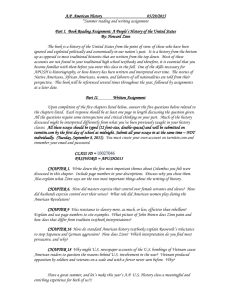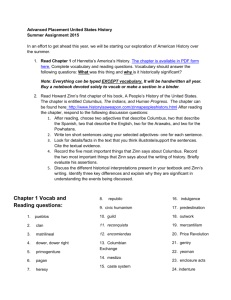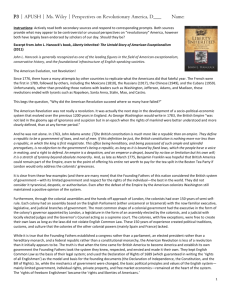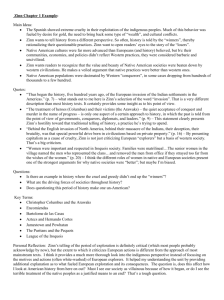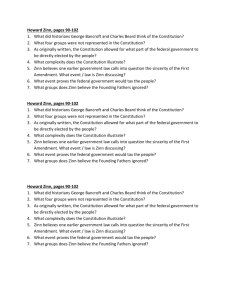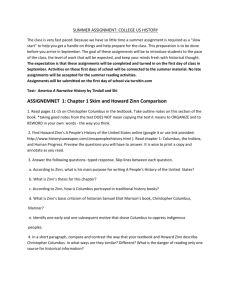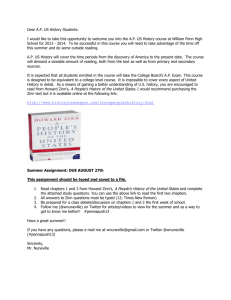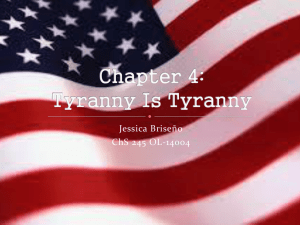A People's History Of The United States Chapter 5
advertisement
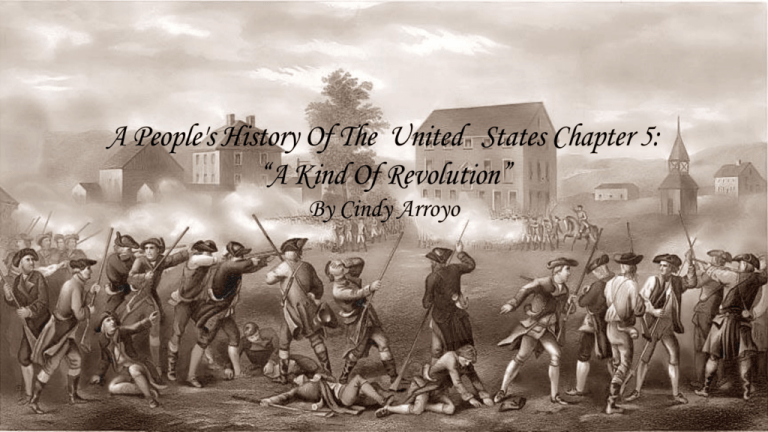
A People's History Of The United States Chapter 5: “A Kind Of Revolution” By Cindy Arroyo Why The Author Chose This Title? ○ ○ The purpose of the revolution was not intended for the good-being of the people as the constitution made it seem. The key motivation for this American war was the struggle for power and control over colonial assets. “...sees the Revolution as a multiplicity of variously oppressed and exploited peoples who preyed upon each other.”(Zinn 88) ○ The revolution did not benefit the poor because it left them right where they started with no gain of wealth. The only thing that they did gain was a new oppressive government. What was the American Revolution? It was an outbreak between the thirteen colonies and Great Britain which began in 1775. Due to the Treaty of Paris,the revolution ended in 1783 resulting in the independence of the colonies and in a new nation that we know as The United States,1776. “...our countrymen have all the folly of the ass and all the passiveness of the sheep….They are determined not to be free….If we were saved, France and Spain must save us.”(Zinn 77) - Alexander Hamilton ○ White men lacked courage and determination to fight for they wanted. A small fraction of men that joined the military service throughout the war stayed. ○ Men wanted in the military were either “hallmarks” of respectability or at least of full citizenship. Indians,free Negroes,white servants and less respectable white men were excluded from the militia. ○ Eventually low class white men were being recruited to the lack of men willing to battle. Effects of the American Revolution ○ Possible separation of the church and state. “The northern states made such declarations,but after 1776 hey adopted taxes that forced everyone to support Christians teachings” (Zinn 83) ○ Opportunities for Revolutionary leaders to become more richer, due the confiscated land from fleeing Loyalists. “It was distributed in such a way as to give a double opportunity to the Revolutionary leaders: to enrich themselves and their friends….”(Zinn 84) ○ Helped end slavery “In the Northern states, the combination of blacks in the military, the lack of powerful economic need for slaves, and the rhetoric of Revolution led to the end of slavery but very slowly.” (Zinn 88) ○ Allowed old customs that benefited the rich to be proclaimed. “...the exclusions Indians from the new society, the establishment of supremacy for the rich and powerful in the new nation all this was already settled in the colonies by the time of the Revolution. With the English out of the way it could now be put on paper,solidified,regularized, made legitimate by the Constitution of the United States…” (Zinn 89) The Constitution ○ Designed to protect our freedom and rights from the government. ○ Assembled in Philadelphia, in the the State House. ○ Signed on September 17,1787 George Bancroft ○ An American historian and Secretary of the Navy who believed that the Constitution was created as a “legal framework for democracy and equality.” (Zinn 90) “The Constitution establishes nothing that interferes with equality and individuality. It knows nothing of differences by descent, or opinions, of favored classes, or legalized religion, or the political power of property. It leaves the individual alongside of the individual. ... As the sea is made up of drops, American society is composed of separate, free, and constantly moving atoms, ever in reciprocal action ... so that the institutions and laws of the country rise out of the masses of individual thought which, like the waters of the ocean, are rolling evermore.” (Zinn 90) -George Bancroft Charles Beard ○ ○ ○ Not everyone agreed that the Constitution was fair. George Beard,a historian, believed the Constitution was a disguise for the rich to “....either control the government directly or control the laws by which the government operates.” (Zinn 90) He researched the economic backgrounds of the men present in Philadelphia in 1787 and found that majority of them were wealthy. “He wanted to make it clear that he did not think the Constitution was written merely to benefit the Founding Fathers personally…...Rather, it was to benefit the groups the Founding Fathers represented, the economic interests they understood and felt in concrete, definite from through their personal experiences.”(Zinn 91) Shay’s Rebellion ○ ○ ○ ○ Named after Daniel Shay who was a veteran of the American Revolutionary War and also one of the leaders of the rebellion. The United States was under debt, after to the revolution, due to Congress borrowing money to pay accumulating interest to foreign investors. Farmers were taxed heavily by the state which caused many farmers to lose their lands because they did not have money to pay the taxes. The rebellion was against the Articles of Confederations due to the amount of laws that did not benefit or helped the working class. James Madison ○ ○ ○ Wrote articles favoring the Constitution, along with Alexander Hamilton and John Jay, came to be known as the Federalist Papers. Would belong to the Democrat- Republican party in the new government. Argued in Federalist Paper #10 that “... representative government was needed to maintain peace in a society ridden by fractional disputes.” (Zinn 96) Faction disputes that Zinn clarifies: “These disputes came from the various and unequal distribution of property.” (Zinn 96) The Role of the Bill Of Rights ○ Series of Amendments that made the Constitution to be more acceptable among the public. “These amendments seemed to make the new government a guardian of peoples liberties: to speak,to publish ,to worship, to petition, to assemble, to be tried fairly, to be secured at home against official intrusion.” (Zinn 99) ○ A concern that was not entirely addressed was if people’ s liberty was safe when put under a government of the rich and powerful . ○ Congressed passed a law opposing the First Amendment seven years after it was passed in 1792 by Congress, known as the Sedition Act of 1798. The Sedition Act of 1798 ○ ○ ○ Passed by John Adams's administration. If anything “false, scandalous and malicious” was said or written to disgrace against the government, Congress or the President it would be considered a crime. It was enforced even though it clearly violated the First Amendment Everyone knew the basic prescription for a wise and just government. It was so to balance the contending powers in society that no one power could overwhelm the others and, unchecked, destroy the liberties that belonged to all. The problem was how to arrange the institutions of government so that this balance could be achieved. - Bernard Bailyn (Zinn 101) ○ The intentions of the Founding Fathers was never to find a balance between the rich and poor. They wanted what benefited the rich and the powerful. “ They certainly did not want an equal balance between slaves and masters, propertyless and property holders, Indians and white.” Zinn(101) Summary ○ ○ ○ In this chapter Zinn developed the idea that the Revolution was mainly concentrated on gaining power and control. The American Revolution did not have major changes in the new nation when it came to who owned the means of production. The powerful and wealthy individuals were the ones to benefit the most than the working class from the revolution. The Founding Fathers were not concern of the welfare of anybody but themselves.As the new mediators of power, The Founding Fathers reflected a similar attitude as the Britsh’s attitude towards the colonist. References Zinn, Howard. “A People’s History of the United States.” New York:HaperPerennial Modern Classics. 2005. Print. Encyclopedia Britannica. “George Bancroft.” 2014. Website.http://www.britannica. com/EBchecked/topic/51366/George-Bancroft History.com Staff. “Shay’s Rebellion”. History.com.A+E Networks.2009. Web. 30 March 2014 Jghprofhist. “Shays Rebellion.” Online video clip. Youtube. Youtube, 19 Oct. 2009. Web. 30 March 2014 Rbelibrary.. “The Constitution.” Online video clip. Youtube. Youtube, 15 Sep. 2013. Web. 30 March 2014 Ted-ed. “A 3-minute guide to the Bills of Rights” Online video clip. Youtube,30 Oct. 2012. Web 31 March 2014
